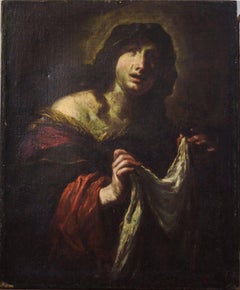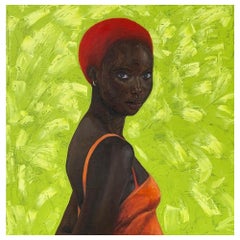(After) Simone Pignoni Art
to
1
Overall Width
to
Overall Height
to
1
1
1
1
1
1
1
1
1
1
1
1
9,989
2,754
1,378
1,375
1
Artist: (After) Simone Pignoni
Saint Veronica
By (After) Simone Pignoni
Located in Roma, IT
18th c. Italian school
Santa Veronica, after Simone Pignoni.
Period copy by an unknown hand of the original oil painting by Pignoni. The original Pignoni painting was conserved in the Church of S. Eusebio in Cegliolo (Cortona) and now in the permanent collection of the Musée Fabre in Montpellier, France. In the Musée des Beaux-Arts of Marseille, there is another period copy by an unknown hand, considered of lesser quality than the current example.
Simone Pignoni (Florence, 1611-1698), one of the most important exponents of the Florentine School, was characterized by a soft touch. His formation with Francesco Furini...
Category
Late 17th Century Old Masters (After) Simone Pignoni Art
Materials
Canvas, Oil
Related Items
Answer Within
Located in Ibadan, Oyo
Painting
Ships in a well-protected tube from Nigeria
This work is unique, this is not a print or other type of copy.
Accompanied by a Certificate of Authenticity (Issued by the Gallery)
Category
21st Century and Contemporary Old Masters (After) Simone Pignoni Art
Materials
Canvas, Oil
18th century French Garden or Féte a Bride and musicians playing music
Located in Woodbury, CT
This enchanting 18th-century French fête galante captures the elegance and joy of aristocratic leisure, set amidst a lush garden adorned with flowers. A scene of refined celebration,...
Category
1780s Old Masters (After) Simone Pignoni Art
Materials
Canvas, Oil
‘Near Sutton, Surrey’ stream and old cottage, 19th C/early 20th C oil on canvas
By Abraham Hulk the Younger
Located in Hillsborough, NC
Dutch/English artist Abraham Hulk the Younger (1851-1922) is most known for landscapes of the British countryside. This work is one of a pair (the second work is also available by s...
Category
Late 19th Century Old Masters (After) Simone Pignoni Art
Materials
Canvas, Oil
$2,800
H 27 in W 22.75 in D 2.13 in
Antique Italian painter - 18th century figure painting
Located in Varmo, IT
Italian painter (18th century) - Chrono.
90.5 x 106 cm.
Antique oil painting on canvas, without frame (not signed).
Condition report: Lined canvas. Good state of conservation of t...
Category
Early 18th Century Old Masters (After) Simone Pignoni Art
Materials
Canvas, Oil
$4,769 Sale Price
20% Off
H 35.63 in W 41.74 in
Mid 19th Century "Susanna And The Elders" After The Old Master by Martinelli
Located in San Francisco, CA
Outstanding Mid 19th century old master "Susanna and the Elders" after Martinelli
Brilliant old master painting of Susanna and the Elders.
Original oil on canvas. Dimensions 26.5" ...
Category
Mid-19th Century Old Masters (After) Simone Pignoni Art
Materials
Canvas, Oil
$1,950 Sale Price
58% Off
H 36 in W 26.5 in D 3 in
CAVALRY BATTLE- Antonio Savisio - Neapolitan School - Oil on canvas Painting,
By Antonio Savisio
Located in Napoli, IT
Land Battle - Antonio Savisio Italia 2006 - Oil on canvas diam. cm. 30
Gold leaf gilded and laquered wooden frame cm. 47x47
Maestro Antonio Savisio drew inspiration from the master...
Category
Early 2000s Old Masters (After) Simone Pignoni Art
Materials
Canvas, Oil
$1,555
H 11.82 in Dm 11.82 in
CHERUBIM WITH FLOWERS- Italian School - Italian Figurative Oil painting
By Giulio Di Sotto
Located in Napoli, IT
Cherubim with flowers - Oil on canvas cm.80x100 by Giulio Di Sotto, Italy, 2002.
Gold leaf gilded wooden frame available on request
This wonderful oil on canvas represents two putti...
Category
Early 2000s Old Masters (After) Simone Pignoni Art
Materials
Canvas, Oil
$4,068
H 31.5 in W 39.38 in
17th Century by Pietro della Vecchia Bacchus and Ceres Oil on canvas
Located in Milano, Lombardia
Pietro della Vecchia (Vicenza, Italy, 1603 – Venice, Italy, 1678)
Title: Bacchus and Ceres
Medium: Oil on canvas
Dimensions: without frame 109 x 130 cm – with frame 128 x 152 x 8 cm...
Category
17th Century Old Masters (After) Simone Pignoni Art
Materials
Canvas, Oil
$53,226 Sale Price
20% Off
H 42.92 in W 51.19 in
17th century Italian school, The Virgin and Child with Saint John the Baptist
Located in PARIS, FR
17th century Italian School
The Virgin and Child with Saint John the Baptist
Oil on canvas
Dimensions: h. 106 cm, l. 77 cm
Important 17th century Italian carved giltwood frame
Fram...
Category
17th Century Old Masters (After) Simone Pignoni Art
Materials
Canvas, Oil
$25,488
H 53.54 in W 42.13 in
18th Century, Antique Oil Painting, Old Master. Portrait of Mother with child.
Located in Berlin, DE
18th century, antique painting, oil on canvas, old master. Mother with child.
Relined canvas.
Stretcher frame also renewed.
Artist unknown.
Category
18th Century Old Masters (After) Simone Pignoni Art
Materials
Canvas, Oil
$5,743 Sale Price
20% Off
H 43.31 in W 34.65 in
CAVALRY BATTLE - Antonio Savisio Neapolitan School Italy Oil on canvas Painting
By Antonio Savisio
Located in Napoli, IT
Land Battle - Antonio Savisio Italia 2006 - Oil on canvas diam. cm. 30
Gold leaf gilded and laquered wooden frame cm. 47x47
Maestro Antonio Savisio drew inspiration from the masterp...
Category
Early 2000s Old Masters (After) Simone Pignoni Art
Materials
Canvas, Oil
Antonio SavisioCAVALRY BATTLE - Antonio Savisio Neapolitan School Italy Oil on canvas Painting, 2006
$1,555
H 11.82 in Dm 11.82 in
18th Century by Matteo Bonechi Presentation of Jesus Painting Oil on Canvas
Located in Milano, Lombardia
Matteo Bonechi (Florence, Italy, 1669 - Florence, Italy, 1756)
Title: Presentation of Jesus
Medium: Oil on canvas
Dimensions: without frame 75 x 49 cm – with frame 89.5 x 65 cm
Shaped, carved and gilded wooden box frame
Not signed
Expertise by Sandro Bellesi, Professor and art historian
Fairs: The International Biennial of Antiques in Florence 2022 (BIAF, Biennale Internazionale dell’Antiquariato di Firenze)
Publications: Bozzetti, modelletti, sketches: dalla collezione di Giorgio Baratti (From the Giorgio Baratti Collection) curated by Anna Orlando, Agnese Marengo and Annalisa Scarpa, Genova, 2022, pp. 20, 21.
The present painting is a very interesting testimony of the creative process of Matteo Bonechi, one of the leading artists on the Tuscan art scene in the early 18th century. The canvas in question is in fact the last preparatory model made by Bonechi before he executed an altarpiece for the church of San Filippo Neri in Cortona in 1716. The scene presented here is that of the Presentation of Jesus, when, forty days after his birth, the child is ransomed through an offering in the temple and placed in the hands of Simeon, who prophesies his future: the coming of the Messiah...
Category
Early 18th Century Old Masters (After) Simone Pignoni Art
Materials
Canvas, Oil
$24,220 Sale Price
20% Off
H 29.53 in W 19.3 in D 1.97 in
(after) Simone Pignoni art for sale on 1stDibs.
Find a wide variety of authentic (After) Simone Pignoni art available for sale on 1stDibs. You can also browse by medium to find art by (After) Simone Pignoni in canvas, fabric, oil paint and more. Much of the original work by this artist or collective was created during the 18th century and earlier and is mostly associated with the Old Masters style. Not every interior allows for large (After) Simone Pignoni art, so small editions measuring 24 inches across are available. (After) Simone Pignoni art prices can differ depending upon medium, time period and other attributes. On 1stDibs, the price for these items starts at $23,514 and tops out at $23,514, while the average work can sell for $23,514.
Questions About (After) Simone Pignoni Art
- Is Raf Simons luxury?1 Answer1stDibs ExpertMarch 25, 2024Yes, Raf Simons was a luxury brand. Belgian-born designer Raf Simons, an alum of Dior and Jil Sander, opened his eponymous label in 1995. The brand earned a reputation for working with materials of the highest quality to create its celebrated pieces and adhered to strict quality standards (these are characteristics that are typical of luxury brands). The brand’s founder shuttered his company in 2023. On 1stDibs, shop a range of vintage Raf Simons apparel and accessories.
- What happened to Raf Simons?1 Answer1stDibs ExpertMarch 13, 2024What happened to Raf Simons is that its founder and designer, Raf Simons, retired. In 2022, Simons announced that his Spring/Summer 2023 collection would be his final one. The Belgian fashion designer launched his label in 1995. On 1stDibs, shop a selection of Raf Simons apparel from some of the world's top boutiques.
- Is Simon G jewelry good?1 Answer1stDibs ExpertAugust 8, 2024Yes, Simon G jewelry is generally considered good in terms of quality. Each piece produced by the jewelry maker is carefully crafted out of premium precious metals, such as 18-karat white and yellow gold. During the manufacturing process, the jewelry undergoes 10 quality assurance checks to ensure that pieces are free of defects. Explore a selection of Simon G jewelry on 1stDibs.
- Is Raf Simons still at Dior?1 Answer1stDibs ExpertApril 5, 2024No, Raf Simons is not still at Dior. The Belgian fashion designer left the French luxury fashion house in 2015. He went on to work for Calvin Klein and Prada, and he also had his own eponymous fashion label. In 2022, Simons announced that his Spring/Summer 2023 collection would be his final one. Shop a collection of Raf Simons apparel and accessories from some of the world's top boutiques on 1stDibs.
- Are Simon G diamonds real?1 Answer1stDibs ExpertOctober 15, 2024Yes, Simon G diamonds are real. The luxury jewelry maker only uses natural gemstones sourced through mining in its jewelry. In addition, the company certifies that all of its diamonds are conflict-free. Shop a range of Simon G jewelry from some of the world's top sellers on 1stDibs.

